Related Research Articles

Charadriiformes is a diverse order of small to medium-large birds. It includes about 390 species and has members in all parts of the world. Most charadriiform birds live near water and eat invertebrates or other small animals; however, some are pelagic (seabirds), others frequent deserts, and a few are found in dense forest. Members of this group can also collectively be referred to as shorebirds.

Seabirds are birds that are adapted to life within the marine environment. While seabirds vary greatly in lifestyle, behaviour and physiology, they often exhibit striking convergent evolution, as the same environmental problems and feeding niches have resulted in similar adaptations. The first seabirds evolved in the Cretaceous period, and modern seabird families emerged in the Paleogene.

Sexual dimorphism is the condition where sexes of the same species exhibit different morphological characteristics, including characteristics not directly involved in reproduction. The condition occurs in most dioecious species, which consist of most animals and some plants. Differences may include secondary sex characteristics, size, weight, color, markings, or behavioral or cognitive traits. Male-male reproductive competition has evolved a diverse array of sexually dimorphic traits. Aggressive utility traits such as "battle" teeth and blunt heads reinforced as battering rams are used as weapons in aggressive interactions between rivals. Passive displays such as ornamental feathering or song-calling have also evolved mainly through sexual selection. These differences may be subtle or exaggerated and may be subjected to sexual selection and natural selection. The opposite of dimorphism is monomorphism, when both biological sexes are phenotypically indistinguishable from each other.

The black-headed gull is a small gull that breeds in much of the Palearctic including Europe and also in coastal eastern Canada. Most of the population is migratory and winters further south, but some birds reside in the milder westernmost areas of Europe. The species also occurs in smaller numbers in northeastern North America, where it was formerly known as the common black-headed gull.

The ruff is a medium-sized wading bird that breeds in marshes and wet meadows across northern Eurasia. This highly gregarious sandpiper is migratory and sometimes forms huge flocks in its winter grounds, which include southern and western Europe, Africa, southern Asia and Australia.
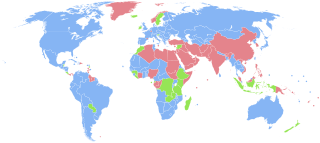
A sex ratio is the ratio of males to females in a population. As explained by Fisher's principle, for evolutionary reasons this is typically about 1:1 in species which reproduce sexually. However, many species deviate from an even sex ratio, either periodically or permanently. Examples include parthenogenic species, periodically mating organisms such as aphids, some eusocial wasps, bees, ants, and termites.
Howard Thomas Odum, usually cited as H. T. Odum, was an American ecologist. He is known for his pioneering work on ecosystem ecology, and for his provocative proposals for additional laws of thermodynamics, informed by his work on general systems theory.

Sequential hermaphroditism is one of the two types of hermaphroditism, the other type being simultaneous hermaphroditism. It occurs when the organism's sex changes at some point in its life. A sequential hermaphrodite produces eggs and sperm at different stages in life. Sequential hermaphroditism occurs in many fish, gastropods, and plants. Species that can undergo these changes do so as a normal event within their reproductive cycle, usually cued by either social structure or the achievement of a certain age or size. In some species of fish, sequential hermaphroditism is much more common than simultaneous hermaphroditism.
Kellogg Biological Station (KBS), Michigan State University's largest off-campus education complex, is located in Ross Township south of Hickory Corners, Michigan. Many of the facilities there were originally built by Will Keith Kellogg of Kellogg's cereal, after whom the station is named. KBS includes nearly 16.5 square kilometres of land and, together with nearby state lands and preserves, allows for large-scale studies by biologists. The National Science Foundation has a Long-Term Ecological Research site at KBS.
The Regius Chair of Zoology is a Regius Professorship at the University of Glasgow. It was founded in 1807 by George III of the United Kingdom as the Regius Chair of Natural History. In 1903, when the Chair of Geology was founded at Glasgow University, the title was changed to Zoology.
In evolutionary biology and evolutionary psychology, the Trivers–Willard hypothesis, formally proposed by Robert Trivers and Dan Willard in 1973, suggests that female mammals adjust the sex ratio of offspring in response to maternal condition, so as to maximize their reproductive success (fitness). For example, it may predict greater parental investment in males by parents in "good conditions" and greater investment in females by parents in "poor conditions". The reasoning for this prediction is as follows: Assume that parents have information on the sex of their offspring and can influence their survival differentially. While selection pressures exist to maintain a 1:1 sex ratio, evolution will favor local deviations from this if one sex has a likely greater reproductive payoff than is usual.
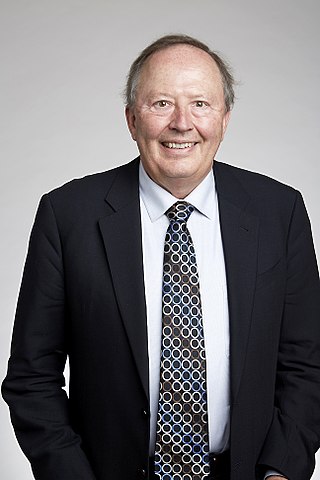
George David Tilman, ForMemRS, is an American ecologist. He is Regents Professor and McKnight Presidential Chair in Ecology at the University of Minnesota, as well as an instructor in Conservation Biology; Ecology, Evolution, and Behavior; and Microbial Ecology. He is director of the Cedar Creek Ecosystem Science Reserve long-term ecological research station. Tilman is also a professor at University of California, Santa Barbara's Bren School of Environmental Science & Management.

Temperature-dependent sex determination (TSD) is a type of environmental sex determination in which the temperatures experienced during embryonic/larval development determine the sex of the offspring. It is observed in reptiles and teleost fish, with some reports of it occurring in species of shrimp. TSD differs from the chromosomal sex-determination systems common among vertebrates. It is the most studied type of environmental sex determination (ESD). Some other conditions, e.g. density, pH, and environmental background color, are also observed to alter sex ratio, which could be classified either as temperature-dependent sex determination or temperature-dependent sex differentiation, depending on the involved mechanisms. As sex-determining mechanisms, TSD and genetic sex determination (GSD) should be considered in an equivalent manner, which can lead to reconsidering the status of fish species that are claimed to have TSD when submitted to extreme temperatures instead of the temperature experienced during development in the wild, since changes in sex ratio with temperature variation are ecologically and evolutionally relevant.
In the evolutionary biology of sexual reproduction, operational sex ratio (OSR) is the ratio of sexually competing males that are ready to mate to sexually competing females that are ready to mate, or alternatively the local ratio of fertilizable females to sexually active males at any given time. This differs from physical sex ratio which simply includes all individuals, including those that are sexually inactive or do not compete for mates.
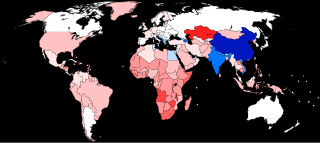
The human sex ratio is the ratio of males to females in a population in the context of anthropology and demography. In humans, the natural sex ratio at birth is slightly biased towards the male sex. It is estimated to be about 1.05 or 1.06 or within a narrow range from 1.03 to 1.06 males per female. The sex ratio for the entire world population is approximately 101 males to 100 females.
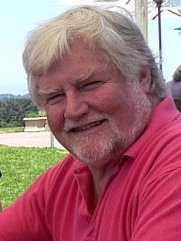
Glenn Daniel Wilson is a psychologist best known for his work on attitude and personality measurement, sexual attraction, deviation and dysfunction, partner compatibility, and psychology applied to performing arts. He is a fellow of the British Psychological Society and makes frequent media appearances as a psychology expert, especially in TV news and documentaries.
Bateman's principle, in evolutionary biology, is that in most species, variability in reproductive success is greater in males than in females. It was first proposed by Angus John Bateman (1919–1996), an English geneticist. Bateman suggested that, since males are capable of producing millions of sperm cells with little effort, while females invest much higher levels of energy in order to nurture a relatively small number of eggs, the female plays a significantly larger role in their offspring's reproductive success. Bateman's paradigm thus views females as the limiting factor of parental investment, over which males will compete in order to copulate successfully.

The term seabird is used for many families of birds in several orders that spend the majority of their lives at sea. Seabirds make up some, if not all, of the families in the following orders: Procellariiformes, Sphenisciformes, Pelecaniformes, and Charadriiformes. Many seabirds remain at sea for several consecutive years at a time, without ever seeing land. Breeding is the central purpose for seabirds to visit land. The breeding period is usually extremely protracted in many seabirds and may last over a year in some of the larger albatrosses; this is in stark contrast with passerine birds. Seabirds nest in single or mixed-species colonies of varying densities, mainly on offshore islands devoid of terrestrial predators. However, seabirds exhibit many unusual breeding behaviors during all stages of the reproductive cycle that are not extensively reported outside of the primary scientific literature.
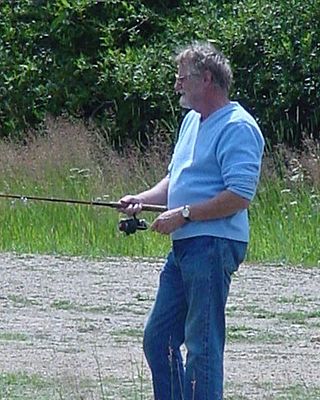
David Pafford Crews is the Ashbel Smith Professor of Zoology and Psychology at the University of Texas at Austin. He has been a pioneer in several areas of reproductive biology, including evolution of sexual behavior and differentiation, neural and phenotypic plasticity, and the role of endocrine disruptors on brain and behavior.
Patricia Monaghan is Regius Professor of Zoology in the School of biodiversity, one health & veterinary medicine at the University of Glasgow.
References
- ↑ Nager, Ruedi G.; Monaghan, Pat; Houston, David C.; Genovart, Meritxell (2000). "Parental Condition, Brood Sex Ratio and Differential Young Survival: An Experimental Study in Gulls (Larus fuscus)". Behavioral Ecology and Sociobiology. 48 (6): 452–457. doi:10.1007/s002650000262. JSTOR 4601840. S2CID 42967.
- ↑ "University of Glasgow :: World Changing:: First experimental demonstration that maternal condition of birds can manipulate the sex ratio of their offspring".
- ↑ "University of Glasgow :: World Changing:: Notable People".
- ↑ University of Glasgow - Prof David C Houston